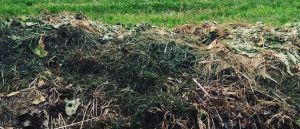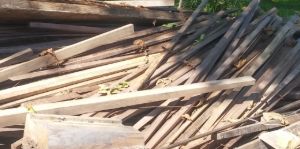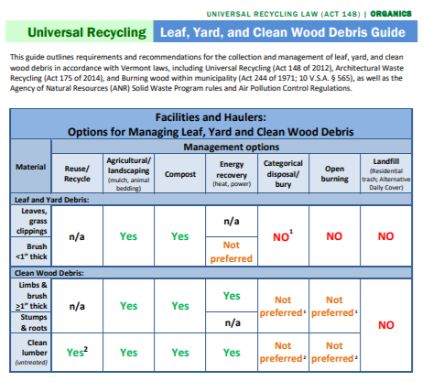Leaf and yard debris and clean wood are banned from the trash. Download the Leaf, Yard, and Clean Wood Debris Guide for more information on what to do with these materials.
What is leaf and yard debris?
- Grass clippings
- Leaves
- Weeds
- Brush less than 1 inch in diameter
- Other compostable, untreated vegetative (plant) matter
What is clean wood?
- Natural wood like logs and branches greater than 1 inch in diameter
- Stumps and roots
- Lumber (including pallets) that has never been painted, stained, or treated
Is any plant matter allowed in the trash?
If weeds, crop residues, and other plant matter contain hazardous substances, composters are unlikely to accept them, so they may be put in the trash as a last resort. Invasive and diseased plant matter is also allowed in the trash as a last resort when composters don't accept them, but many composters do accept these materials. Scroll down to learn more.
Can I move ash brush and wood off my property now that the Emerald Ash Borer (EAB) has infested ash trees in Vermont?
It depends on whether a tree is visibly infested by the insects and the time of year. Follow the Recommendations to Slow the Spread of Emerald Ash Borer. Learn more about the Emerald Ash Borer at VTinvasives.org.
 What should I do with my...?
What should I do with my...?
Leaves, grass, and brush:
- Compost at home: Compost needs carbon-rich “browns” in addition to “greens” (food scraps). Dried leaves and grass provide the perfect carbon source to keep your backyard compost balanced and odor-free. Learn more on our compost page.
- Make a brush pile: If you have space on your property and want to enhance its value as wildlife habitat, stack your debris into a strategic pile. Birds, small mammals, butterflies, and other wildlife forage or cache food in brush piles and shelter in them during harsh weather.
- Drop-off at a compost facility: Some compost facilities accept leaf and yard debris in addition to food scraps. Find a facility near you on our Materials Management Map. Click on the green apple cores to see what each compost facility accepts.
- Drop-off at a waste facility: All transfer stations and “fast trash” haulers that accept trash must also accept leaf and yard debris between April 1 and December 15.
- Ask your hauler if they collect leaves, grass, and brush.
Invasive plant species:
Because small piles rarely get hot enough, backyard composting invasive plants, such as Japanese Knotweed, might not kill the plants. Instead, kill invasive species on-site by methods such as solarization or desiccation (techniques are species specific—learn more at VTinvasives.org). Leave the dead plant material on-site if possible.
If you need to move the material off-site, ideally kill the invasive species, including seeds and other reproductive parts, and then:
- Compost facilities and transfer stations may accept invasive species material; ask your local waste district or town if there is a place to drop off the material near you. Do not drop off invasive species material without permission. Even composters that accept some species may want to be aware of what they take in so they can manage the material properly.
- If local facilities will not accept the invasive species material and it cannot be managed on-site, invasive species material may be put in the trash as a last resort. Double-bag it if you are not sure if it is completely dead or if there might be flowers or seeds attached. If you need to dispose of a large quantity of invasive species, please contact the landfill directly for instructions.
Have questions? Learn more at VTinvasives.org or contact the VTinvasives team. For composting questions, explore our food scraps webpage or call 802-828-1138.
Diseased garden plants:
- Bury diseased plant material away from your garden. Backyard compost piles usually do not get hot enough to kill the diseases, so backyard composting is not recommended.
- Some compost facilities and leaf and yard drop-offs accept diseased plants. Ask your local waste district or town for drop-off options near you.
- Diseased plants may be put in the trash as a last resort.
Learn more about disease prevention in home gardens from University of Missouri Extension.
Larger pieces of wood, stumps, and roots:
- Leave onsite: Downed woody debris provides important habitat for animals.
- Build with it: Let your creativity loose and create benches, walkways, planters, trellises, or other structures for your garden.
- Give it away: But if you're moving ash wood, follow the Recommendations to Slow the Spread of Emerald Ash Borer.
- Bring to your local Stump Dump: check with your Waste District or Town if you need assistance.
Clean lumber:
- Repurpose or Give Away: If you can’t use it at home, check your Waste District or Town for local reuse options.
- Burn: In your wood stove or backyard campfire (but it’s illegal and toxic to burn treated/painted wood).
- Drop-off at a waste facility: Transfer stations and “fast trash” haulers are not required to collect clean lumber, but many do. Check with your local facilities.
- Learn about local options from your Waste District or town or find a waste facility near you with our materials management map. Zoom in on your region and click on the recycling symbols to see what is accepted by each facility.
Treated wood:
- Re-purpose or Give Away: If you can’t use it at home, check your Waste District or Town for local reuse options.
- If you can't find a use for it, in most instances, plywood, oriented strand board, pressure-treated wood, and any wood that has been painted, stained, or treated can go in the trash. Learn more from our Treated Wood Fact Sheet. To learn more about disposal of architectural wood waste, go to the Construction and Demolition Waste page.
- Burning treated wood is illegal and could create toxic fumes.
Can I burn leaf and yard debris?
Open burning of vegetative matter, such as weeds and crop residue, as a means of disposal is not allowed by the DEC Air Pollution and Control Regulations. It is permissible under those Regulations to burn for the purpose of weed abatement; disease, forest fire, and pest prevention or control; and for the purpose of agricultural, forestry, or wildlife habitat management. Also allowed is burning of material such as brush and tree cuttings that are accrued as part of normal property maintenance. For more information on open burning, visit the Air Quality & Climate Division website or call at 802-828-1288.

